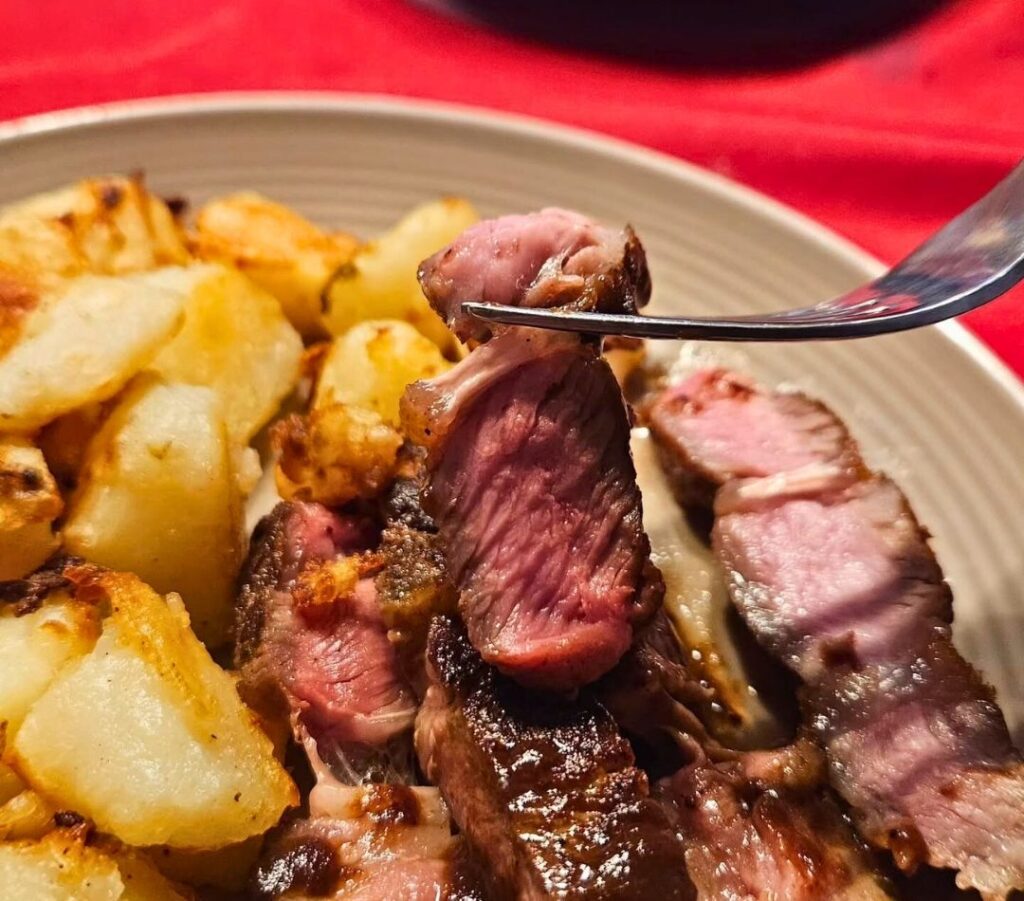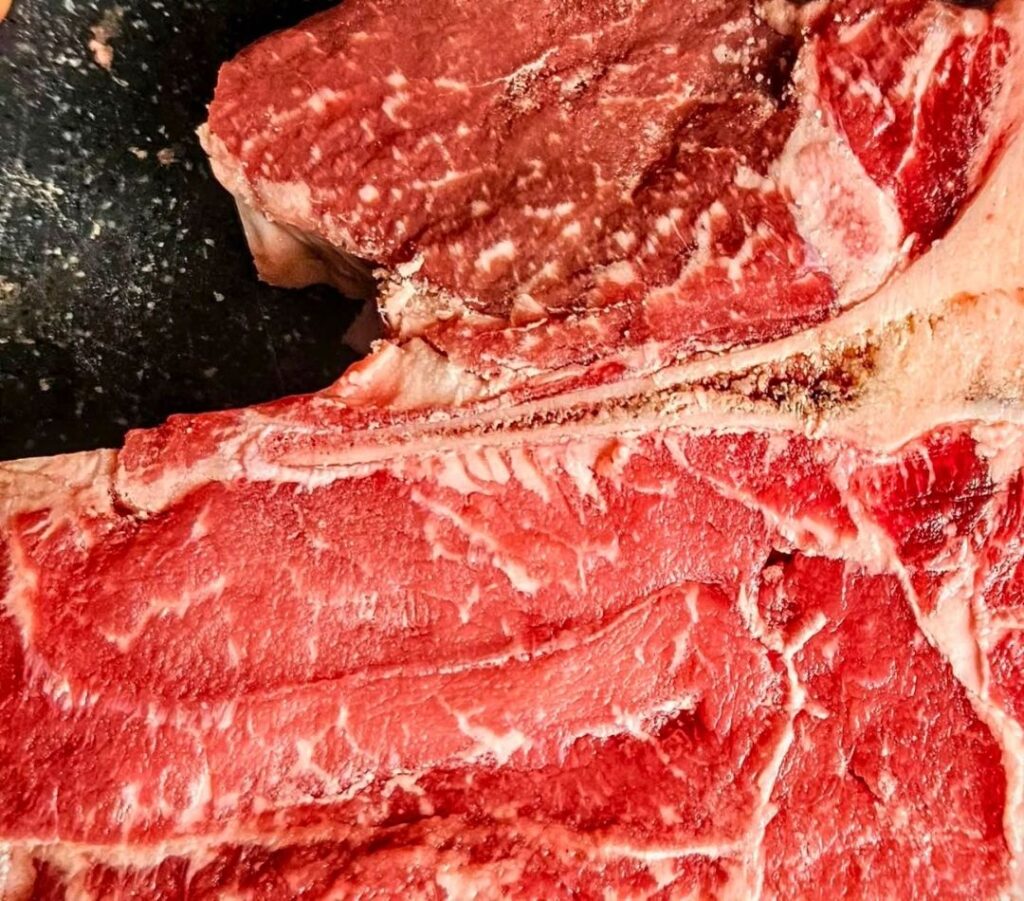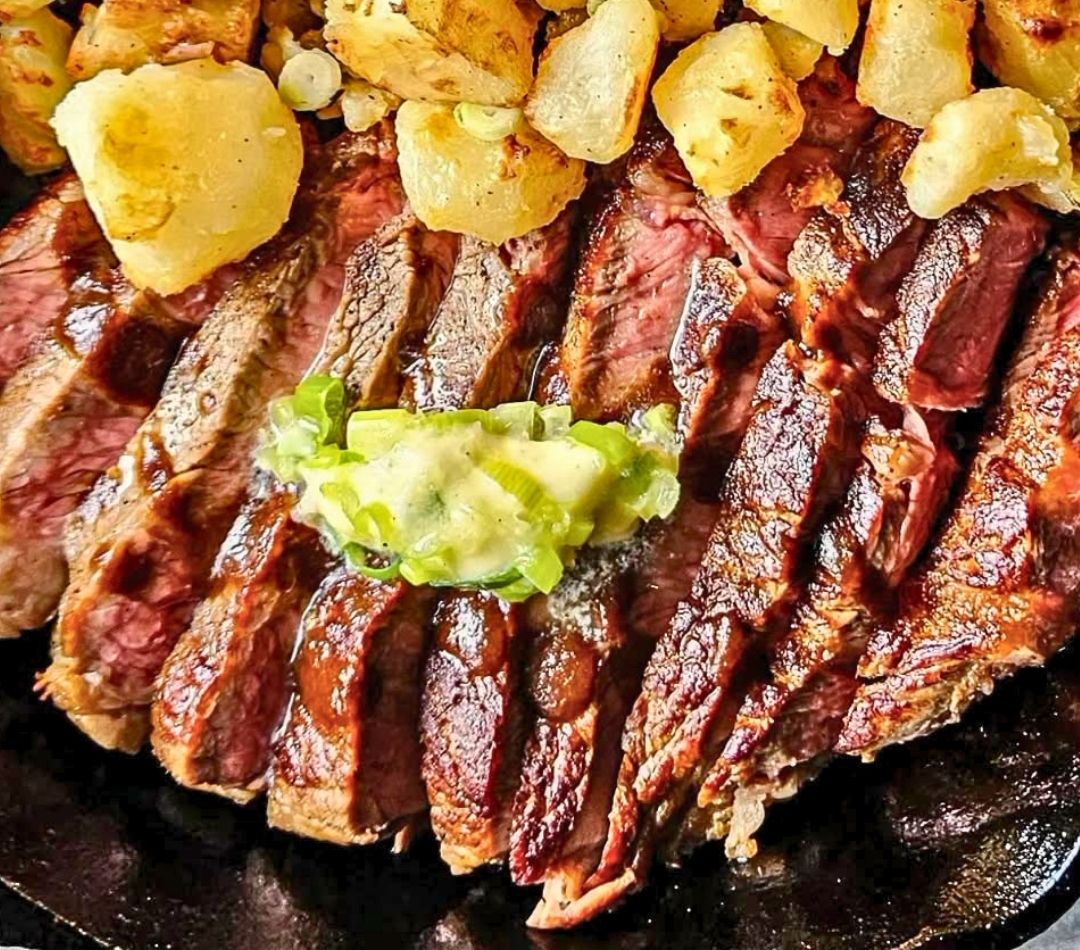When done right, a porterhouse steak is more than just a meal—it’s an experience. Rich, marbled, and flavor-packed, this cut brings the best of both worlds: the tender filet and the bold strip steak. Paired with golden-crispy roasted potatoes and a drizzle of scallion-infused butter, this cast-iron seared porterhouse is a no-fuss, high-reward dish that’ll satisfy any steakhouse craving without leaving your kitchen. It’s gluten-free, straightforward to prepare, and the kind of dinner that earns repeat status in your rotation.
Whether you’re cooking for a date night or just treating yourself to a well-deserved meal, this is how you turn simple ingredients into something unforgettable.
What Makes a Porterhouse So Special?

A porterhouse steak is often mistaken for a T-bone, but the difference is all in the size of the filet. Porterhouse includes a generous portion of tenderloin and a hearty strip steak, both divided by a T-shaped bone. The dual-texture cut delivers a complex eating experience: buttery soft on one side, robust and beefy on the other.
It’s a steakhouse favorite—and when prepared correctly at home, it’s a dish that can rival the best restaurants.
Choosing the Right Cut
Start by selecting a thick-cut porterhouse, ideally at least 1.5 inches thick. Thickness helps ensure a good sear on the outside while maintaining a juicy center. Look for visible marbling throughout, and if possible, buy from a local butcher or trusted meat counter where the quality is consistent.
For the best results, avoid pre-seasoned or pre-tenderized cuts. You want total control over the flavor from start to finish.
Dry Brining: The Key to Flavor and Texture

Before you even heat your pan, the steak needs time to dry brine. This means seasoning it liberally with kosher salt and freshly ground pepper, then letting it rest uncovered in the fridge for at least 1 hour. This step:
- Enhances the natural beef flavor
- Encourages a better crust when seared
- Helps retain internal moisture during cooking
You can dry brine for up to 24 hours in advance—longer rest, deeper flavor.
Perfect Crispy Roasted Potato Wedges
While the steak rests and the skillet heats, prep your oven-roasted potato wedges. These offer the perfect starchy complement to the rich beef and butter. The secret to crispiness? A high oven temperature and a good blend of seasonings.
What you’ll need:
- 4 large russet or Yukon gold potatoes
- Olive oil
- Paprika for subtle smokiness
- Garlic powder for umami depth
- Dried rosemary to lift the overall flavor
Toss everything together and roast at 425°F (220°C) for 30–35 minutes. Make sure to flip the wedges halfway through for even browning.
Searing the Steak: Cast-Iron is Non-Negotiable

For a true steakhouse-style crust, a cast-iron skillet is your best friend. It retains and distributes heat evenly and is perfect for creating that deep brown sear that defines a well-cooked steak.
Steps to success:
- Heat the pan over high heat until it’s lightly smoking.
- Add a high-smoke point oil if needed (like avocado or canola), though a dry pan often works fine due to the steak’s natural fat.
- Sear the steak undisturbed for 3–4 minutes per side for medium-rare (use a meat thermometer to be sure—130°F internal temp).
- Let the steak rest for 5–10 minutes off heat to allow juices to redistribute.
This step is often skipped, but it’s crucial. Cutting into the steak too soon will let the flavorful juices spill out onto the cutting board instead of staying in the meat where they belong.
Making the Scallion Herb Butter
While the steak rests, create the final touch: a warm scallion butter that elevates the whole dish with an herby, aromatic flair.
Here’s how:
- In the same pan (don’t wipe it clean—you want those steak drippings), melt 2 tablespoons of unsalted butter over medium heat.
- Add finely chopped scallions (about 2 per steak) and cook until softened and fragrant, about 2–3 minutes.
- Optional: add a pinch of lemon zest or crushed red pepper for a little zing or heat.
The butter absorbs all the residual flavor from the pan and creates a silky, savory finish that coats the steak beautifully.
Plating Like a Pro

Presentation matters—especially when you’re going steakhouse-style at home.
- Slice the porterhouse across the grain and arrange it slightly fanned out on a plate.
- Drizzle the scallion butter generously over the top, allowing it to seep into the slices.
- Serve with a side of the crispy roasted potato wedges.
- Optional: sprinkle with flaky sea salt or fresh herbs for color and crunch.
Pair with a crisp salad or sautéed greens for balance, and you’ve got a full, satisfying meal.
Customization and Substitutions
This recipe is adaptable without compromising flavor:
- Butter alternatives: Swap in ghee or a plant-based butter for dairy-free diners.
- Potatoes: Try sweet potatoes or carrots for a lower glycemic option.
- Steak variations: If porterhouse isn’t available, ribeye or New York strip can be used instead—just adjust searing times based on thickness.
If you’re cooking for more than two, scale the ingredients up and consider oven-finishing your steaks for even cooking.
Storing & Reheating Tips

If you happen to have leftovers (unlikely, but possible), here’s how to keep them tasting great:
- Store in an airtight container in the fridge for up to 3 days.
- Reheat steak gently in a 250°F oven until warmed through—avoid the microwave, which toughens the meat.
- Re-crisp potatoes in the oven or an air fryer to restore texture.
You can also repurpose steak slices into wraps, salads, or steak-and-egg breakfasts the next day.
Final Thoughts
Steak night doesn’t have to mean a reservation and a triple-digit tab. With a quality porterhouse cut, a heavy-duty cast iron skillet, and a few pantry staples, you can achieve the same results—sometimes better—right at home. The combination of crispy potato wedges and scallion butter brings everything together with minimal effort and maximum flavor.
This dish is straightforward, satisfying, and the kind of meal you’ll be proud to serve again and again. Whether you’re a seasoned home cook or just starting out, it’s a recipe worth mastering.

Cast-Iron Seared Porterhouse Steak with Scallion Herb Butter & Crispy Roasted Potatoes
Ingredients
Method
- Season the porterhouse steak generously with kosher salt and freshly ground black pepper on both sides. Place uncovered on a rack in the refrigerator and dry brine for at least 1 hour, up to 24 hours for deeper flavor.
- Preheat the oven to 425°F (220°C). In a large bowl, toss potato wedges with olive oil, paprika, garlic powder, and dried rosemary until evenly coated. Arrange the potatoes in a single layer on a baking sheet.
- Roast the potatoes in the preheated oven for 30–35 minutes, flipping halfway through, until golden brown and crispy.
- While the potatoes roast, heat a cast-iron skillet over high heat until very hot and slightly smoking.
- Place the dry-brined porterhouse steak into the hot skillet and sear without moving for 3 to 4 minutes to develop a deep crust. Flip and sear the other side for an additional 3 to 4 minutes for medium-rare doneness. Adjust cooking time for your preferred level.
- Remove the steak from the skillet and transfer to a plate or cutting board. Tent loosely with foil and let rest for 5 to 10 minutes to allow juices to redistribute.
- In the same skillet used for the steak, reduce heat to medium. Add the unsalted butter and melt.
- Add the finely chopped scallions and cook in the butter for 2 to 3 minutes until softened and fragrant.
- Slice the rested steak against the grain and arrange on serving plates. Spoon the warm scallion herb butter over the sliced steak.
- Serve immediately with the crispy roasted potato wedges.
Notes
- Dry brining the steak for up to 24 hours intensifies flavor and improves texture.
- Resting the steak after searing is essential to retain juices and achieve tender results.
- Use a cast-iron skillet for the best sear and crust formation.
- Adjust cooking times based on steak thickness and desired doneness.


Leave a Reply